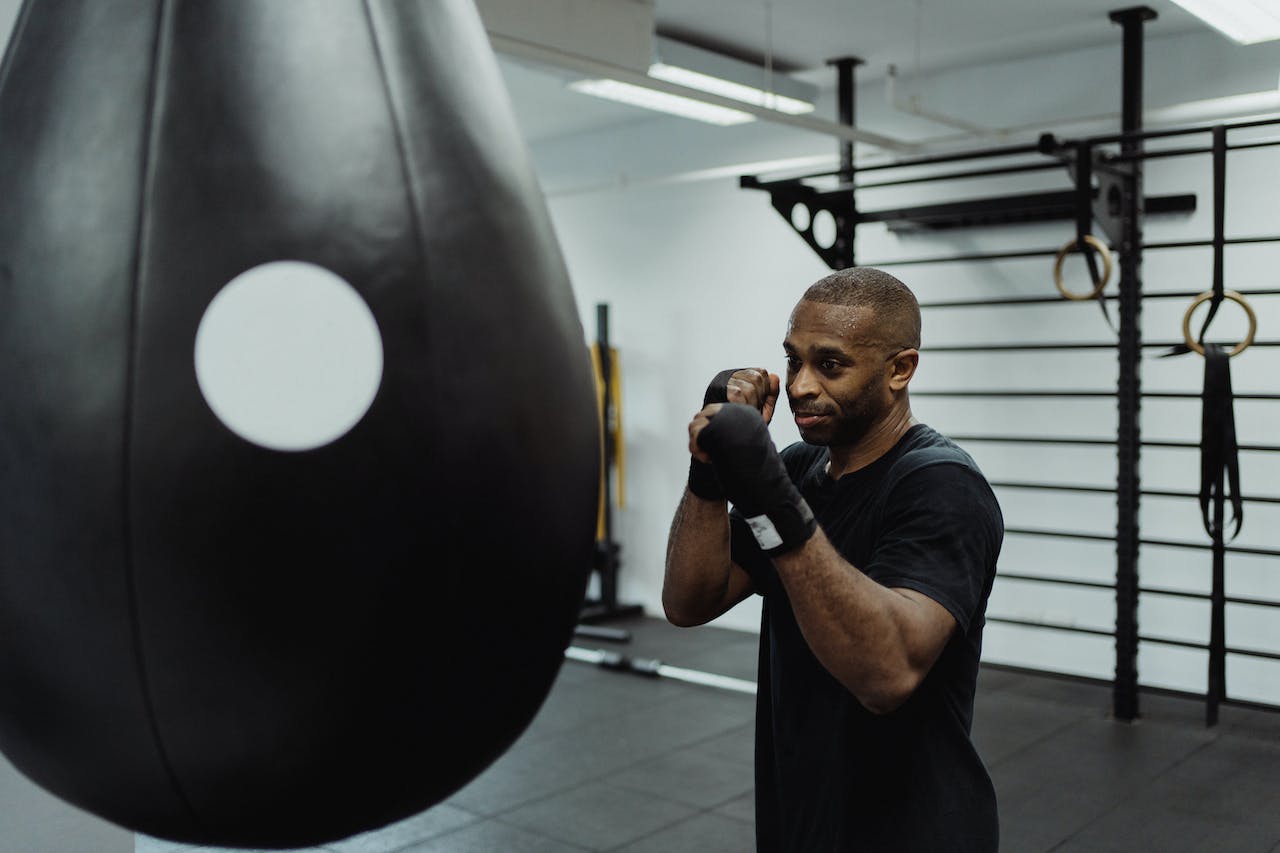
Effective Speed Bag Setup at Home: A Guide for Boxers
Growing up, I always admired the speed and precision of professional boxers as they effortlessly unleashed rapid-fire punches on a small, elusive target – the speed bag. To bring that exhilarating training experience into your own home, proper setup is key. In this guide, we’ll explore the benefits of having a speed bag at home, the essential gym equipment needed, and step-by-step instructions to create an effective setup.
By incorporating boxing speed bag training into your boxing routine, you can enhance your hand-eye coordination, timing, and overall punching technique.
Hanging and Adjusting Your Speed Bag
Types of Speed Bag Platforms
There are different types of speed bag platforms available for setting up a speed bag at home. Some popular options include free-standing frames, wall-mounted brackets, and support bars. Each option has its own advantages and considerations.
Proper Height and Distance
When hanging your speed bag, it’s important to consider the proper height and distance. The height should be set so that the bottom of the bag is level with your chin or slightly below. This allows for optimal punching technique and timing. The distance between the bag and the wall or platform should be about an arm’s length away to provide enough space for movement.
Adjusting Tension and Swivel
To ensure optimal performance, it’s crucial to adjust the tension and swivel of your speed bag. The tension refers to how tight or loose the ball is inflated inside the punching bag. It’s recommended to start with medium tension and adjust accordingly based on personal preference. The swivel hook, which connects the bag to the platform, should allow for smooth rotation without excessive wobbling or resistance.
Tips for Stability
To prevent any accidents or instability while using your speed bag, it’s essential to secure the platform properly. If you’re using a free-standing frame, make sure it is weighted down with sandbags or other heavy objects to prevent tipping over during intense training sessions. For wall-mounted brackets or support bars, use strong fasteners that can withstand constant impact.
Setting up a speed bag at home for boxing requires careful consideration of various factors such as choosing the right platform type, adjusting height and distance correctly, fine-tuning tension and swivel settings, as well as ensuring stability through proper securing methods.
Read Also: How to Select the Right Boxing Bag Stand for Your Home Gym
Tips for Effective Speed Bag Training
Start with basic rhythm and timing exercises
To get started with speed bag training, it’s essential to begin with some basic rhythm and timing exercises. This helps you develop a feel for the bag and its movements. Start by hitting the bag lightly and gradually increase your speed as you become more comfortable. Focus on maintaining a consistent rhythm and timing your strikes accurately.
Gradually increase speed and intensity as you progress
As you gain proficiency in speed bag training, it’s crucial to continuously challenge yourself by gradually increasing the speed and intensity of your punches. Push yourself to hit the bag faster while maintaining control and accuracy. This will improve your hand-eye coordination, reflexes, and overall boxing skills.
Focus on accuracy and precision while hitting the bag
When training with a speed bag, it’s not just about how fast you can hit it; accuracy and precision are equally important. Concentrate on landing clean hits on specific areas of the bag, such as the center or edges. This will help refine your aim, enhance your punching technique, and simulate real-life scenarios in the ring.
Incorporate different combinations and footwork drills
To make your speed bag training more dynamic and challenging, incorporate various combinations of punches into your routine. Practice throwing jabs, hooks, uppercuts, and crosses in different sequences to improve your boxing repertoire. Integrate footwork drills like shuffling or pivoting while striking the bag to simulate movement during a fight.
By following these tips for effective speed bag training – starting with basic rhythm exercises, gradually increasing speed/intensity, focusing on accuracy/precision, and incorporating different combinations/footwork drills – you’ll be well on your way to improving your boxing skills.
Read Also: Are Standing Boxing Bags Good?
Different Ways to Hang a Speed Bag
Setting up a speed bag at home for boxing can be a game-changer in your training routine. But how do you hang it properly? Let’s explore different ways to hang a speed bag and find the best option for you.
Wall-mounted platforms vs. freestanding platforms
One popular method is using wall-mounted platforms. These sturdy structures are attached to the wall, providing stability and allowing you to adjust the height of the speed bag easily. On the other hand, freestanding platforms offer more flexibility as they don’t require installation. They come with their own base, usually filled with sand or water for stability.
Using a ceiling mount or beam attachment for hanging the bag
If you have limited space or prefer not to use a platform, consider using a ceiling mount or beam attachment. These options allow you to hang the speed bag from above, utilizing your existing ceiling or beams. Just make sure that the structure can support the weight and movement of the bag.
Portable options for those with limited space or mobility
For those who need portability or have limited space, there are portable speed bag setups available. These typically consist of an adjustable stand with a swivel attachment where you can hang your speed bag. Portable options are great if you need to move your setup around or if you don’t have access to walls or ceilings.
Pros and cons of each hanging method
Wall-mounted platforms:
-
Pros: Sturdy, adjustable height
-
Cons: Requires installation
Freestanding platforms:
-
Pros: Portable, easy setup
-
Cons: Less stable than wall-mounted options
Ceiling mount/beam attachment:
-
Pros: Utilizes existing structure
-
Cons: Limited by ceiling height and support capacity
Portable setups:
-
Pros: Easy to move around, no installation required
-
Cons: Less stable than wall-mounted options
Choose the hanging method that suits your space, budget, and training needs. Remember to use similar fasteners recommended by the manufacturer for secure installation.
Proper Technique for Hitting a Speed Bag

Correct Hand Position and Wrist Alignment
Proper hand position and wrist alignment are crucial. You want to make sure your hands are positioned correctly on the bag, with your knuckles facing forward. This allows you to generate maximum power and accuracy in your punches. It’s important to keep your wrists aligned with your forearms to avoid any strain or injury.
Utilizing Both Hands in Alternating Patterns or Single-Handed Techniques
To get the most out of your speed bag training, it’s essential to utilize both hands. You can practice alternating patterns by hitting the bag with one hand at a time, switching back and forth between your dominant and non-dominant hand. This helps improve coordination and rhythm. Alternatively, you can also work on single-handed techniques by focusing solely on one hand while the other rests at your side.
Read Also: The Must-Have Gym Accessories to Enhance Workout Experience
Maintaining a Consistent Rhythm and Tempo
Maintaining a consistent rhythm and tempo is key when working with a speed bag. It helps develop timing, speed, and precision in your punches. Try to establish a steady beat as you strike the bag, keeping each punch evenly spaced apart. This will not only enhance your overall boxing skills but also provide an effective cardiovascular workout.
Avoiding Excessive Force or Overreaching
While it may be tempting to go all out on the speed bag, it’s important to avoid using excessive force or overreaching during standing boxing bag training sessions. Remember that speed bag workouts focus more on technique rather than raw power. By striking the bag with controlled movements instead of forcefully swinging at it, you’ll improve accuracy and minimize the risk of injury.
By following these tips for setting up a boxing bag for sale at home for boxing, you’ll be well on your way to mastering this essential training tool.
Maximizing Cardio and Endurance with the Speed Bag
Incorporating interval training into your speed bag routine can take your cardio and endurance to the next level. By alternating between high-intensity bursts of punching and short rest periods, you’ll challenge your cardiovascular system and build stamina.
To increase the intensity of your workout, try adding punches, footwork, or defensive movements while hitting the speed bag. This not only engages different muscle groups but also simulates real-life boxing scenarios, improving your overall martial arts skills.
Monitoring your heart rate during a speed bag session is an important aspect of optimizing its cardiovascular benefits. Keep an eye on your heart rate using a fitness tracker or by checking your pulse manually. Aim for a target heart rate zone that corresponds to a moderate-to-vigorous intensity level for maximum cardio benefits.
Progressively challenging yourself is key to improving endurance with the speed bag. Start by gradually increasing the duration of each session as you build up stamina. Once you feel comfortable with longer sessions, focus on increasing the speed at which you hit the bag without sacrificing technique.
Remember, variety is crucial. Mix up your speed bag routine by incorporating different punch combinations, footwork drills, or even shadowboxing in front of a mirror while hitting the bag.
By following these tips and consistently incorporating them into your workouts, you’ll be able to maximize cardio and endurance gains with the speed bag.
Setting Up a Speed Bag at Home Made Easy
You are now equipped with the knowledge and tips you need to set up a speed bag at home for your boxing training. By following the steps outlined in this blog post, you’ll be able to hang and adjust your speed bag correctly, learn proper hitting techniques, and maximize your cardio and endurance.
Now it’s time to put all that knowledge into action! Shop a high-quality speed bag now start by finding the perfect spot in your home to hang your speed bag. Visit our gym equipment Perth store today. Remember, it should be a sturdy location that allows for free movement around the bag. Once it’s hung, make sure to adjust the height and tension of the bag according to your preference.
With everything set up, get ready to unleash your inner boxer! Practice hitting the speed bag using proper technique, focusing on rhythm and precision. As you build momentum and improve your skills, don’t forget to push yourself further by incorporating different drills and intensifying your workouts.
FAQs
How long should I train with the speed bag each day?
It’s recommended to start with short sessions of 5-10 minutes per day when beginning with a speed bag. As you progress and improve your skills, gradually increase the duration of your training sessions to 20-30 minutes.
Can I use any gloves while hitting the speed bag?
Yes, wearing gloves while hitting the speed bag is highly recommended. Gloves provide protection for your hands and wrists from potential injuries caused by repetitive impact.
What type of surface is best for hanging a speed bag?
A solid wooden beam or metal frame is ideal for hanging a speed bag securely. Avoid hanging it on weak or unstable surfaces that may compromise your safety during training.
How can I prevent the speed bag from swinging too wildly?
To control the swing of the speed bag, make sure it is properly inflated and adjust the tension according to your preference. Maintaining a consistent rhythm and hitting the bag with precision will help minimize excessive swinging.
Can speed bag training help improve my hand-eye coordination?
Absolutely! Speed bag training is renowned for enhancing hand-eye coordination. The constant movement and quick reflexes required to hit the bag accurately will sharpen your coordination skills over time.
